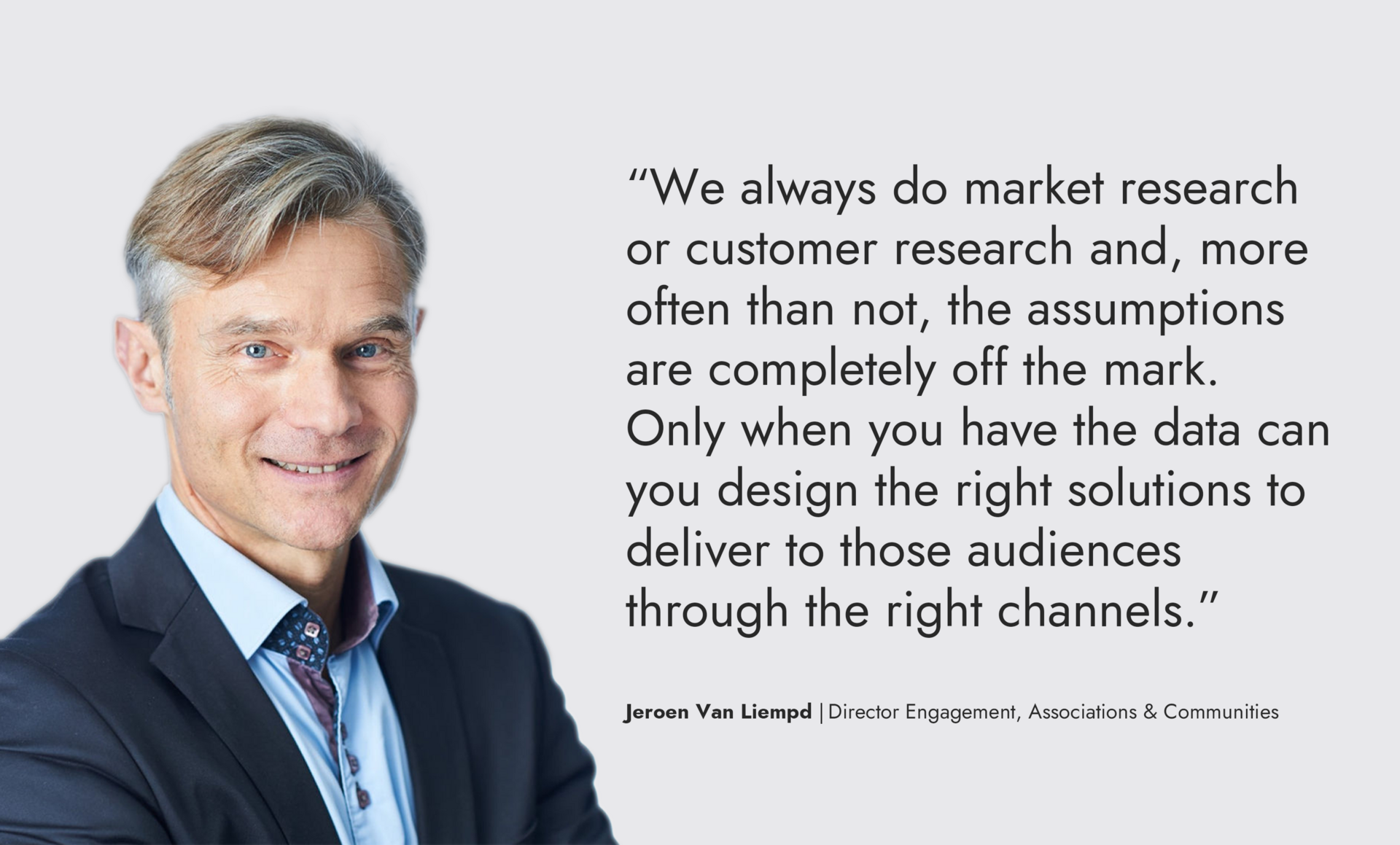
What are the key steps to building a value-driven strategic relationship with your association clients?
When I think about the foundations of strategic account management, it comes down to really wanting to understand the client’s business and their ecosystem. And the way we unpack that is by applying Simon Sinek’s Golden Circle: asking why, how and what: Why is the client doing what they do? How do we support that strategically? And what should we do to execute our mandate?
Only with those answers, can you move from account management into strategic account management and advise the clients on the strategy; only then can you design the implementation and, of course, execute.
We ask these questions because we really need to understand their world. For example, if we're dealing with an association of hand surgeons, of course we are not hand surgeons but we need to understand their ecosystem.
So we are curious and ask questions all the time. One of the big misunderstandings is that this stops after the initial client meeting and then it’s business as usual. It’s not. It’s every day and indeed from time to time we’ll suggest a strategic retreat where we take stock. We do a quarterly business review. And it’s important to build in these moments.
And this all goes towards long-term relationship building and retention, doesn’t it?
Yes. Of course, we have the data driven side – the facts and the figures. But then we have, let's say: the soft side. You need to be genuinely interested in building a relationship. You need to be a communicator.
People buy from people. People work with people, and that will never change, and they need to feel that you're genuinely interested both on the business side and the human side. And what’s important here is how we communicate the value of what we do, and how we explain and clarify what we believe the association client should focus on or should change.
Our account managers and their teams ask the why, how and what questions all the time, because it also applies to MCI – we also need to evaluate whether we are doing things right, if we are efficient, if what we’re doing makes sense, if it gets the right results and if it doesn't. And if we have doubts, then we need to flag it up. This goes for how we do membership management, how we create new revenue streams, the publications or educational events.
When a client signals an issue or problem, it's usually too late. We aim to anticipate and be interested and give focused attention all the time. That ensures that we know when we need to talk about things and we make sure we are the ones to ask the question, not the client. This is how you retain clients.

Associations often have unique goals and missions. How do you align your strategic account management approach with the specific objectives of the associations you work with, especially considering the cultural nuances involved?
Once we’ve got the answers to our first round of why, what and how questions, the next move is to take a deep dive into the organisation’s mission, their strategy, their activities, their business model, their ecosystem.
This would include a PEST (political, economic, social and technological) analysis and a SWOT (strengths, weaknesses, opportunities and threats) analysis. Only then can you even think about the objectives and what they need to do and how you can advise them on strategy, objectives and possible stumbling blocks.
Knowing their business, knowing their ecosystem includes the governance side. What is their governance model? How are they organised? Does it enable them to work towards the decided outcomes? Does the way they manage themselves and the way we manage them make sense?
In order for us to be an efficient account management and strategic partner we also need to recognise what kind of leadership they have culturally. How involved the leadership is. The characteristics of that leadership. Do they have gaps or blind spots that perhaps they don't see themselves?
All of that – their ecosystem, their business model, the governance model and their leadership culture – defines how we can be the best partner for them.
So the partnership is determined by different angles of the business: the external and the internal business, the external environment, and also the culture.
How do you ensure that you drive value for our clients?
Well, of course, once you have a strategy and you know the objectives, you know what the goals are. Then the work of executing and driving towards these goals starts.
The way we make sure that we drive value is by constantly checking whether the activities we undertake with them and for them produce the desired outcomes. We check in all the time to ensure that everything we do still makes sense for the mission and if it makes business sense. When we believe things are not going in the right direction, we address it.
That's really the only way. It’s always in a state of flux and you’re always tweaking direction to make sure that you’re still on course.

In your experience, what key strategies have proven effective in expanding the reach and influence of associations beyond their home country?
It is important to have a very good understanding and knowledge of the desires and the needs of the target audiences that the association is trying to serve. These decisions need to be data driven, not based on what you think you know or what the leadership of the organisation think they know.
We always do market research or customer research and, more often than not, the assumptions are completely off the mark. Only when you have the data can you design the right solutions to deliver to those audiences through the right channels.
Not every business culture or country favours the same channels to receive services or to receive communications. Communication is very culturally sensitive. And sometimes a service or product of an organisation needs to be adapted in order to make it relevant in another country. It’s essential to know what you need to adapt, and how you need to deliver it.
Can you share an example of a particularly challenging international association account that you managed and how you navigated the cultural and business differences to achieve success?
We started working with this particular client more than a decade ago. Their secretariat was in North America but they wanted to be seen as an international organisation. We moved their secretariat to MCI Brussels, becoming a truly global headquarters. At first, we assumed a secretariat role, making ends meet and getting to know “the business” inside out. Then slowly but surely, we switched to a strategic role and began to advise them on what needed to be done and that to build the organisation outside of North America would require a different approach as their management had been rather US-centric up to that point. The challenge for us was gaining their trust to build the business.
This involved making sure that products and services were adapted to be more country- and business-sensitive to other cultures. We brought online new activities and products that were relevant to the regions that they wanted to develop in a very focused way.
They are now active in almost all regions of the world and the business is successful. This can be seen as a success story, but it gave me a lot of grey hairs as well.

How do you approach building and maintaining strong relationships with international association clients?
The first thing that comes to mind is our QBR – the quarterly business review I mentioned earlier, where we check in with our clients in a structural manner. You have to have your antenna working and always be switched on to potential issues, but from time to time – every quarter at least – you formally check in and review the business relationship, the personal relationship and where you are with the strategy – what is going well, what is not going well.
A 360˚ quarterly business review is important in building personal rapport as the client then knows that they have your attention and that they have a chance at least every quarter to have this very open discussion. That for me has been a fantastic tool in building relationships.
With your extensive background in international account management, can you highlight a situation where you had to adapt your strategic approach?
Well, typically in the past if an association wanted to set up an office in another region, we would run that office for them; we’d be their feet on the ground, serving their constituencies and reporting back to HQ staff, who were often in the US.
The trouble with this model is that associations would often launch regional offices before they had a well-designed, realistic and fully endorsed business plan in place. There was always the expectation that within six months they’d have results, but time has shown that this approach can be improved.
Nikki Walker, MCI’s Global Vice President Engagement - Associations & Communities, worked with the American Society of Association Executives to set up a global maturity assessment to help organisations assess to what extent they are ready for international growth – to make sure that they have the right plans in place, they've done the market research, they've got the right leadership support, that all the noses are in the same direction. It covers everything that will increase the success rate of actually going global.
Quite recently an organisation wanted me to open an office and we pushed back and convinced them to first do this assessment, then we built a plan with them and only then we started to work together in the European region where they wanted to help.

Finally, what skills are essential for the role of a strategic account manager?
My skills triangle is the ability to listen, the capacity to build a trust-based consultative relationship, and the talent to communicate extremely well:
1. Be an active listener. Rather than talking about what MCI can do and what our services are, develop the skill of listening to learn what the organisation is, what they need, where they are and where they want to get to. We’re listening all the time.
2. Be comfortable shifting between supporting and advising. You need to be able to show a very supportive energy while at the same time being able to make decisions immediately when they look to you and say, “So what do we need to do now?” It's a very fine line. In the end, they are the organisation, they take the ultimate decision, but we also play a consultative role. If you have gained their trust they will listen to your advice, and you build trust by building and nurturing the relationship.
3. Communication skills are also vital. One of our most important services is helping organisations express their value to their constituencies, to convey the right messaging regarding their strategy, and to communicate between themselves. So as a strategic account manager for MCI you must be a strong communicator on the business side and also on the personal side – it is essential to have that rapport with our clients.
Watch Jeroen talk about the importance of a global strategy for Association growth:
Find out more about the solutions that MCI offers associations, societies and organisations, or contact us today.




